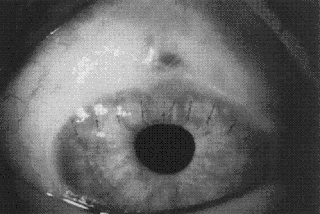Another factor that may be associated with the improved long-term IOP control with combined procedures is the adjunctive use of antimetabolites to minimize excessive fibrosis. The first of these to be evaluated was 5-fluorouracil (5-FU), which is typically administered as several postoperative subconjunctival injections. Although preliminary experience with combined ECCE and trabeculectomy suggested some benefit (130), subsequent studies showed no significant difference with or without adjunctive 5-FU (131,132). Result of studies with combined phacoemulsification and trabeculectomy have shown little (133,134) or no (135) benefit to 5-FU.
| Figure 44.2. Slit-lamp view of eye with functioning glaucoma-filtering bleb in which extracapsular cataract extraction and posterior chamber lens implantation were performed through a clear corneal incision to preserve the preexisting bleb. (From Ritch R, Shields MB, Krupin T, eds. The glaucomas, 2nd ed. St. Louis: CV Mosby, 1996:1751, with permission.) |
| Figure 44.3. Intraoperative view during guarded sclerectomy and phacoemulsification showing excision of fistula from posterior lip of scleral tunnel incision. |
When intraoperative mitomycin-C (MMC) was used in conjunction with combined cataract extraction and trabeculectomy, earlier studies did not demonstrate significant benefits of using MMC (136,137), although IOP was well controlled at 6 to 12 months postoperatively (138,139). More recently, several randomized studies have found greater IOP control with the use of MMC in combined glaucoma and cataract surgery (140,141,142,143).

